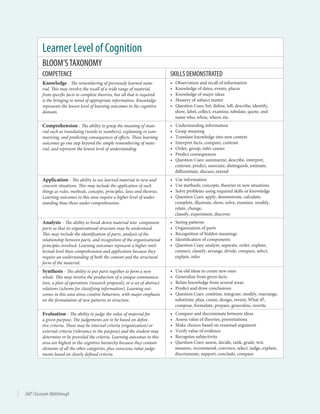
360 Blooms Taxonomy
- 1. 3600 Classroom Walkthrough Learner Level of Cognition BLOOM’STAXONOMY COMPETENCE SKILLS DEMONSTRATED Knowledge - The remembering of previously learned mate- rial. This may involve the recall of a wide range of material, from specific facts to complete theories, but all that is required is the bringing to mind of appropriate information. Knowledge represents the lowest level of learning outcomes in the cognitive domain. • Observation and recall of information • Knowledge of dates, events, places • Knowledge of major ideas • Mastery of subject matter • Question Cues: list, define, tell, describe, identify, show, label, collect, examine, tabulate, quote, and name who, when, where, etc. Comprehension - The ability to grasp the meaning of mate- rial such as translating (words to numbers), explaining or sum- marizing, and predicting consequences of effects. These learning outcomes go one step beyond the simple remembering of mate- rial, and represent the lowest level of understanding. • Understanding information • Grasp meaning • Translate knowledge into new context • Interpret facts, compare, contrast • Order, group, infer causes • Predict consequences • Question Cues: summarize, describe, interpret, contrast, predict, associate, distinguish, estimate, differentiate, discuss, extend Application - The ability to use learned material in new and concrete situations. This may include the application of such things as rules, methods, concepts, principles, laws and theories. Learning outcomes in this area require a higher level of under- standing than those under comprehension. • Use information • Use methods, concepts, theories in new situations • Solve problems using required skills or knowledge • Question Cues: apply, demonstrate, calculate, complete, illustrate, show, solve, examine, modify, relate, change, classify, experiment, discover Analysis - The ability to break down material into component parts so that its organizational structure may be understood. This may include the identification of parts, analysis of the relationship between parts, and recognition of the organizational principles involved. Learning outcomes represent a higher intel- lectual level than comprehension and application because they require an understanding of both the content and the structural form of the material. • Seeing patterns • Organization of parts • Recognition of hidden meanings • Identification of components • Question Cues: analyze, separate, order, explain, connect, classify, arrange, divide, compare, select, explain, infer Synthesis - The ability to put parts together to form a new whole. This may involve the production of a unique communica- tion, a plan of operations (research proposal), or a set of abstract relations (scheme for classifying information). Learning out- comes in this area stress creative behaviors, with major emphasis on the formulation of new patterns or structure. • Use old ideas to create new ones • Generalize from given facts • Relate knowledge from several areas • Predict and draw conclusions • Question Cues: combine, integrate, modify, rearrange, substitute, plan, create, design, invent, What if?, compose, formulate, prepare, generalize, rewrite Evaluation - The ability to judge the value of material for a given purpose. The judgements are to be based on defini- tive criteria. These may be internal criteria (organization) or external criteria (relevance to the purpose) and the student may determine or be provided the criteria. Learning outcomes in this area are highest in the cognitive hierarchy because they contain elements of all the other categories, plus conscious value judge- ments based on clearly defined criteria. • Compare and discriminate between ideas • Assess value of theories, presentations • Make choices based on reasoned argument • Verify value of evidence • Recognize subjectivity • Question Cues: assess, decide, rank, grade, test, measure, recommend, convince, select, judge, explain, discriminate, support, conclude, compare